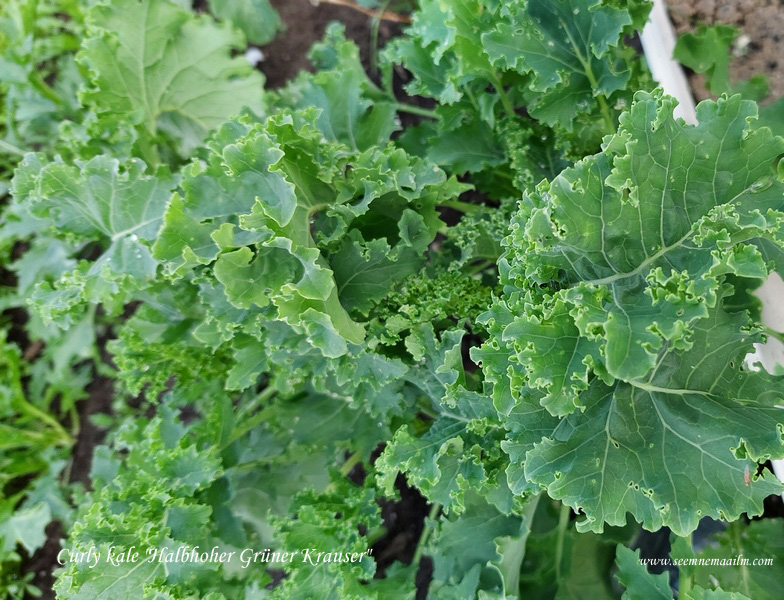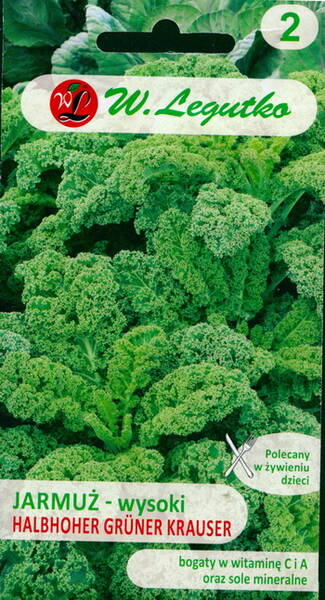Your shopping cart is empty!
Curly kale "Halbhoher Grüner Krauser"
Brassica oleracea convar. acephala (DC) Alef var. sabellica L.
1.48€
Ex Tax: 1.20€
Ex Tax: 1.20€
Curly kale "Halbhoher Grüner Krauser".
A medium-ready variety, a very decorative variety that is not only good for salads with a high content of vitamins and minerals, but also an ornamental crop.
Curly kale can be eaten fresh. To do this, cut it into small pieces, sprinkle it with lemon juice and add any pleasant oil, lemon juice activates the beneficial substances of cabbage.
Salad additives can be different: walnuts, sunflower seeds, herbs, boiled eggs and corn. Season with salt and pepper to taste.
The edible part of curly kale is the leaves, which are removed gradually, starting from the bottom of the plant.
Ornamental curly cabbage can delight you until the New Year if you transplant it into a large flower pot and bring it indoors.

Agricultural technology.
Location: plants reach their full development at the end of summer, are photophilous, relatively cold-resistant, easily tolerate spring and autumn frosts. Cold days only enhance the brightness of the color of its leaves. In the adult state, curly kale can withstand a short-term drop in temperature to -8-12°C. Seedlings of ornamental cabbage can withstand temperatures as low as -4°C.
Curly kale can grow in partial shade. Only in this case it will be smaller and the color will not be as intense as in the sun.
Soil: prefer loamy or sandy loamy soils rich in humus.
Care: loves the "good life" when it is watered, loosened and fed. At the first top dressing after planting, nitrogen or organic fertilizers are given. This allows you to accelerate the growth and development of plants. On fertile soils, 2-3 top dressings with an interval of 7-10 days are enough. On poor soils, 4-5 such dressings are needed. Do not feed ornamental cabbage with manure. Otherwise, you will get plants with huge leaves, but also with a predominance of green tones in color. It should be watered abundantly in dry weather. Naturally, regular watering is necessary at the beginning of growth. Leaf coloring begins only when cool weather sets in.
Diseases and pests: To keep the beauty of cabbage perfect, do not forget about pest control. Spraying after rain with a solution of superphosphate (100 g per 10 liters of water) will help in the fight against caterpillars of the white butterfly. In wet weather, the plant must be protected from slugs (the easiest way is to sprinkle the ground around the plants with ash or fallen needles).
Reproduction: seeds (1 g contains 350 pieces). To obtain 100 plants, you need 0.5 g of seeds.
Cabbage is sown in the last decade of March in pots with a diameter of 3-4 cm. They are filled with a mixture of peat, leaf soil and sand in a ratio of 2:2:1 and watered. Two seeds are placed in each pot to a depth of 1 cm and covered with a substrate. If the air temperature is within + 18 + 20 ° C, shoots will appear in 2-5 days. At lower temperatures, seed germination is delayed. They often die from fungal diseases, mainly from the "black leg". The easiest way to protect seedlings is proper watering. The earth is shed before and immediately after sowing. Then watering is stopped and the seedlings are only slightly sprayed. You can water already grown seedlings with significant drying of the soil.
Seedling care consists in timely watering and two top dressings: nitroammophos or universal Kemira (1 tablespoon per m2). The first is carried out when the second true leaf appears, the second - two weeks before planting in open ground. Particular attention should be paid to the temperature of growing seedlings.
So that the plants do not stretch, they are placed in a cooler and well-lit place with a temperature of + 12 + 16 ° C.
After 35-40 days, hardened seedlings are planted in a permanent place (at the end of April - beginning of May). When planting in groups, a distance of 50-60 cm is left between individual plants. Curly kale grows faster than white cabbage. Therefore, it can be sown directly into the ground from April 25 to May 9. It is better to do this in a small greenhouse covered with non-woven covering material (agril, lutrasil, etc.). Plants sown directly into the ground will be smaller than those grown through seedlings, but they will have time to “bloom”.
A medium-ready variety, a very decorative variety that is not only good for salads with a high content of vitamins and minerals, but also an ornamental crop.
Curly kale can be eaten fresh. To do this, cut it into small pieces, sprinkle it with lemon juice and add any pleasant oil, lemon juice activates the beneficial substances of cabbage.
Salad additives can be different: walnuts, sunflower seeds, herbs, boiled eggs and corn. Season with salt and pepper to taste.
The edible part of curly kale is the leaves, which are removed gradually, starting from the bottom of the plant.
Ornamental curly cabbage can delight you until the New Year if you transplant it into a large flower pot and bring it indoors.

Agricultural technology.
Location: plants reach their full development at the end of summer, are photophilous, relatively cold-resistant, easily tolerate spring and autumn frosts. Cold days only enhance the brightness of the color of its leaves. In the adult state, curly kale can withstand a short-term drop in temperature to -8-12°C. Seedlings of ornamental cabbage can withstand temperatures as low as -4°C.
Curly kale can grow in partial shade. Only in this case it will be smaller and the color will not be as intense as in the sun.
Soil: prefer loamy or sandy loamy soils rich in humus.
Care: loves the "good life" when it is watered, loosened and fed. At the first top dressing after planting, nitrogen or organic fertilizers are given. This allows you to accelerate the growth and development of plants. On fertile soils, 2-3 top dressings with an interval of 7-10 days are enough. On poor soils, 4-5 such dressings are needed. Do not feed ornamental cabbage with manure. Otherwise, you will get plants with huge leaves, but also with a predominance of green tones in color. It should be watered abundantly in dry weather. Naturally, regular watering is necessary at the beginning of growth. Leaf coloring begins only when cool weather sets in.
Diseases and pests: To keep the beauty of cabbage perfect, do not forget about pest control. Spraying after rain with a solution of superphosphate (100 g per 10 liters of water) will help in the fight against caterpillars of the white butterfly. In wet weather, the plant must be protected from slugs (the easiest way is to sprinkle the ground around the plants with ash or fallen needles).
Reproduction: seeds (1 g contains 350 pieces). To obtain 100 plants, you need 0.5 g of seeds.
Cabbage is sown in the last decade of March in pots with a diameter of 3-4 cm. They are filled with a mixture of peat, leaf soil and sand in a ratio of 2:2:1 and watered. Two seeds are placed in each pot to a depth of 1 cm and covered with a substrate. If the air temperature is within + 18 + 20 ° C, shoots will appear in 2-5 days. At lower temperatures, seed germination is delayed. They often die from fungal diseases, mainly from the "black leg". The easiest way to protect seedlings is proper watering. The earth is shed before and immediately after sowing. Then watering is stopped and the seedlings are only slightly sprayed. You can water already grown seedlings with significant drying of the soil.
Seedling care consists in timely watering and two top dressings: nitroammophos or universal Kemira (1 tablespoon per m2). The first is carried out when the second true leaf appears, the second - two weeks before planting in open ground. Particular attention should be paid to the temperature of growing seedlings.
So that the plants do not stretch, they are placed in a cooler and well-lit place with a temperature of + 12 + 16 ° C.
After 35-40 days, hardened seedlings are planted in a permanent place (at the end of April - beginning of May). When planting in groups, a distance of 50-60 cm is left between individual plants. Curly kale grows faster than white cabbage. Therefore, it can be sown directly into the ground from April 25 to May 9. It is better to do this in a small greenhouse covered with non-woven covering material (agril, lutrasil, etc.). Plants sown directly into the ground will be smaller than those grown through seedlings, but they will have time to “bloom”.
For garnish: cut the cabbage leaves into large pieces (it is better to tear off) and cook for 6-8 minutes. Fill with water only 2.5-3 cm.
When cooking, add only peeled lemon. Place the leaves on a plate and drizzle with olive oil.
Sprinkle with herbs, add thin slices of fried bacon to the table. Decorate the plate with small cherry tomatoes...
* Doctors confirm that a rich cabbage side dish is the best addition to a fried meat meal.












